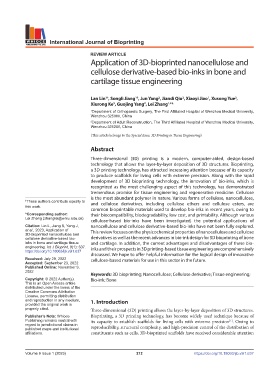Page 220 - IJB-9-1
P. 220
International Journal of Bioprinting
REVIEW ARTICLE
Application of 3D-bioprinted nanocellulose and
cellulose derivative-based bio-inks in bone and
cartilage tissue engineering
Lan Lin , Songli Jiang , Jun Yang , Jiandi Qiu , Xiaoyi Jiao , Xusong Yue ,
2
1†
1†
1
2
2
Xiurong Ke , Guojing Yang , Lei Zhang *
1,2
2
2
1 Department of Orthopaedic Surgery, The First Affiliated Hospital of Wenzhou Medical University,
Wenzhou 325000, China
2 Department of Adult Reconstruction, The Third Affiliated Hospital of Wenzhou Medical University,
Wenzhou 325200, China
(This article belongs to the Special Issue: 3D Printing in Tissue Engineering)
Abstract
Three-dimensional (3D) printing is a modern, computer-aided, design-based
technology that allows the layer-by-layer deposition of 3D structures. Bioprinting,
a 3D printing technology, has attracted increasing attention because of its capacity
to produce scaffolds for living cells with extreme precision. Along with the rapid
development of 3D bioprinting technology, the innovation of bio-inks, which is
recognized as the most challenging aspect of this technology, has demonstrated
tremendous promise for tissue engineering and regenerative medicine. Cellulose
is the most abundant polymer in nature. Various forms of cellulose, nanocellulose,
† These authors contribute equally to and cellulose derivatives, including cellulose ethers and cellulose esters, are
this work.
common bioprintable materials used to develop bio-inks in recent years, owing to
*Corresponding author: their biocompatibility, biodegradability, low cost, and printability. Although various
Lei Zhang (zhanglei@wmu.edu.cn)
cellulose-based bio-inks have been investigated, the potential applications of
Citation: Lin L, Jiang S, Yang J, nanocellulose and cellulose derivative-based bio-inks have not been fully explored.
et al., 2023, Application of This review focuses on the physicochemical properties of nanocellulose and cellulose
3D-bioprinted nanocellulose and
cellulose derivative-based bio- derivatives as well as the recent advances in bio-ink design for 3D bioprinting of bone
inks in bone and cartilage tissue and cartilage. In addition, the current advantages and disadvantages of these bio-
engineering. Int J Bioprint, 9(1): 637. inks and their prospects in 3D printing-based tissue engineering are comprehensively
https://doi.org/10.18063/ijb.v9i1.637
discussed. We hope to offer helpful information for the logical design of innovative
Received: July 29, 2022 cellulose-based materials for use in this sector in the future.
Accepted: September 23, 2022
Published Online: November 9,
2022
Keywords: 3D bioprinting; Nanocellulose; Cellulose derivative; Tissue engineering;
Copyright: © 2022 Author(s). Bio-ink; Bone
This is an Open Access article
distributed under the terms of the
Creative Commons Attribution
License, permitting distribution
and reproduction in any medium, 1. Introduction
provided the original work is
properly cited. Three-dimensional (3D) printing allows the layer-by-layer deposition of 3D structures.
Publisher’s Note: Whioce Bioprinting, a 3D printing technology, has become widely used technique because of
Publishing remains neutral with its capacity to establish scaffolds for living cells with extreme precision . Owing to
[1]
regard to jurisdictional claims in
published maps and institutional reproducibility, structural complexity, and high-precision control of the distribution of
affiliations. constituents such as cells, 3D-bioprinted scaffolds have received considerable attention
Volume 9 Issue 1 (2023) 212 https://doi.org/10.18063/ijb.v9i1.637

